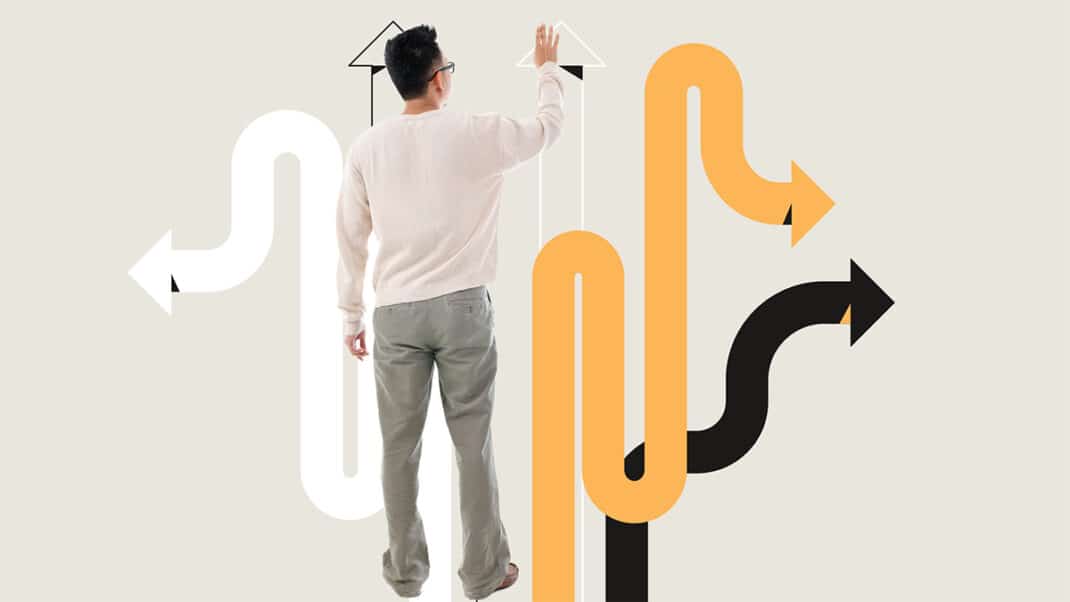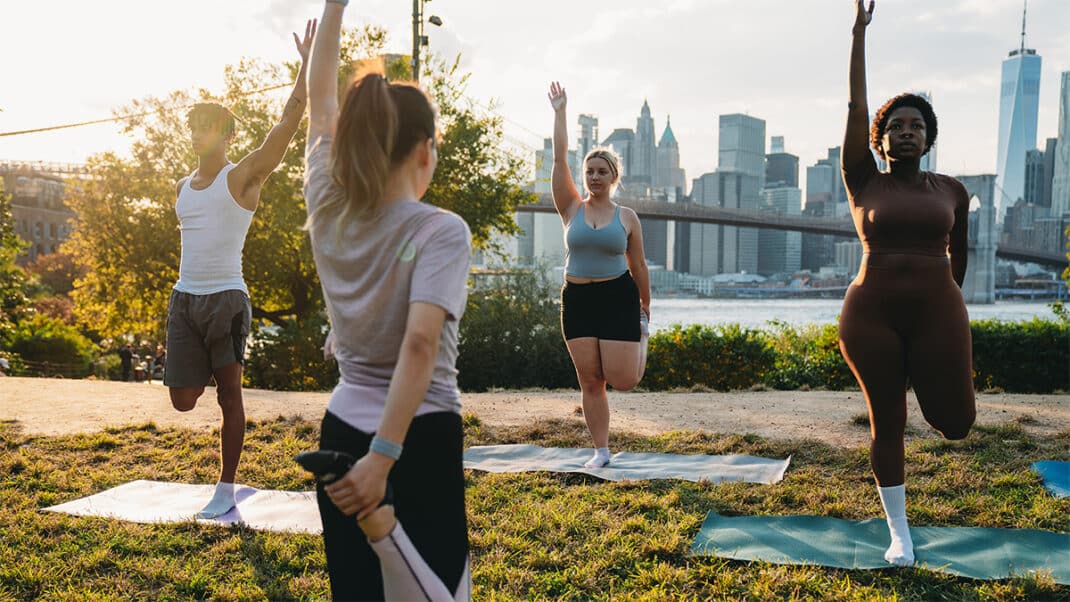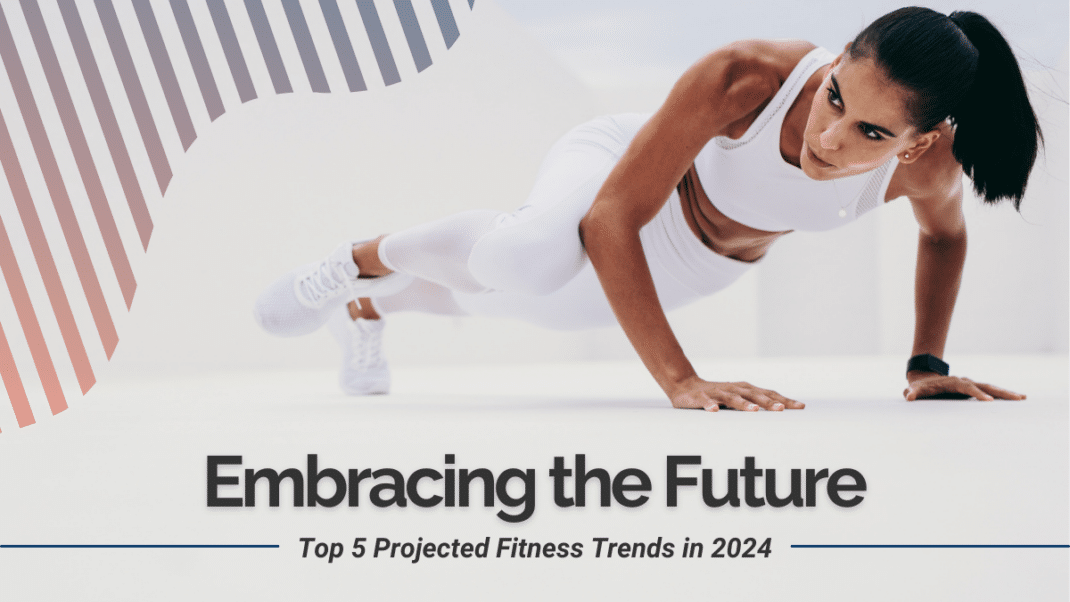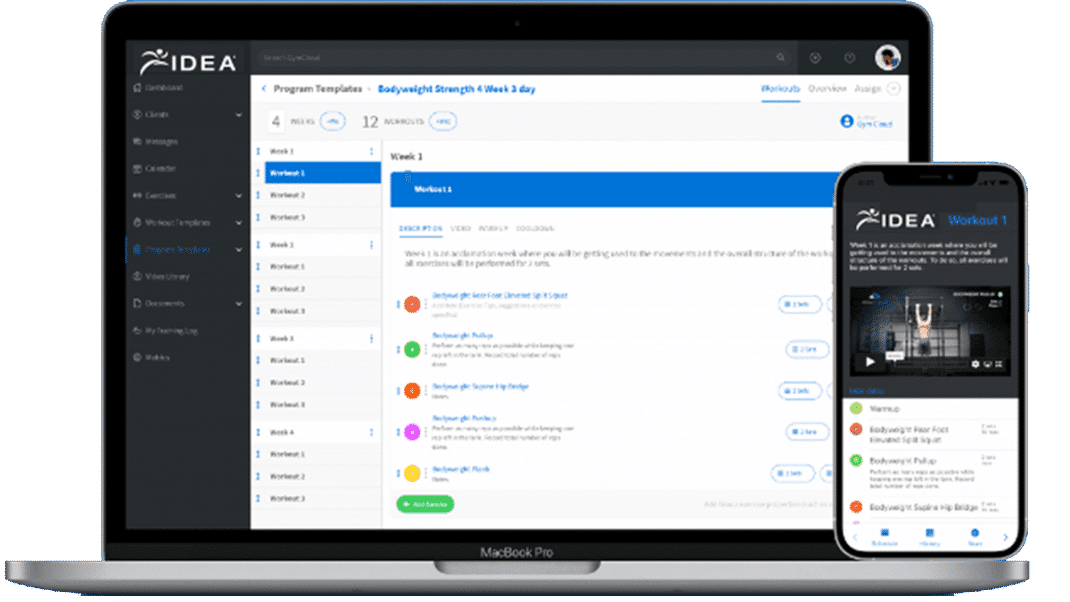Making Essential Adjustments for Fitness Industry Growth
How to navigate new and potential industry career pathways.

Change can be challenging, even when a course correction is necessary for both the greater good of fitness industry growth and our own individual success. We have long viewed ourselves as essential parts of the allied health professional community, so the response from politicians, legislators and even the public during COVID-19 gym shutdowns was bewildering for many of us. However, as we know from our work with clients, recognizing the need to change is an important first step in building a better future for fitness industry growth.
“We are at a defining moment in the industry, and not just for fitness professionals, but [for] employers, the public and the medical community,” says Graham Melstrand, executive vice president of community health and wellness services at the American Council on Exercise and an ACE-certified personal trainer. The shutdown may have been the wake-up call that will help us elevate our status as the highly trained health and wellness professionals that we are—and educate others on the difference between us and the erstwhile influencer with a dangerous workout du jour.
“I think it would be fantastic to have the respect of the public and the medical community; however, we need to gain respect within our own industry first,” says Sara Kooperman, JD, CEO and owner of SCW Fitness Education.
Here, Melstrand, Kooperman and seven other industry experts weigh in on where we are, where we’re going and how we, as individuals, can be a force for positive change for fitness industry growth.
See also: The Essential Role of Fitness and Physical Activity: Hope for the Future
Let’s Be Clear: A Case for Specificity of Language
We know the importance of using clear cues in workout classes. Accurate and specific language helps everyone share an understanding of what’s going on. The same is true outside the confines of the gym.
“We do ourselves a disservice by aligning with the single word fitness,” notes Debbie Bellenger, MA, MBA, CEO and owner of Body by Definition. “The word is really too small for what we do. Fitness professionals are capable of expanding into more than just prescribing exercise programs.”
But before we work out the more nuanced language, we would benefit from delineating between a fully dedicated fitness professional and one who is more of a hobbyist.
What We Can Do: Draw Distinctions
An amalgam of industry sources defines a full-time fitness professional as an individual who may have a college degree (bachelor’s, master’s, doctorate) in exercise science or a related field; holds at least one foundational, nationally recognized fitness certification (and likely has one or more specialty certifications); and has worked full time for at least 3 years in the industry (performing assessments and daily duties with clients, implementing classes or programs, and referring out as necessary, plus many business and administrative tasks).
A hobby fitness professional (sometimes called a hobby instructor) teaches fitness classes or conducts personal training sessions (or does both) part time. These individuals may hold at least one national certification, and they likely possess training focused primarily on a few specific formats, equipment types or techniques. Teaching or training is not their primary source of income, and their daily duties do not include working in a fitness facility with clients or teaching classes continually.
Both of these types of fitness professionals are committed to the industry, but the full-time pros are completely dedicated, making their living by inspiring clients to move better and feel better. This statement is not meant to diminish what part-timers accomplish and provide—but to encourage us all to properly acknowledge those who spend more time and money and put in more hours to our cause for fitness industry growth.
Training Plan: Enhancing Our Education
Organizations like the United States Registry of Exercise Professionals® (USREPS) advocate for fitness professionals to hold NCCA-accredited exercise certification(s), but attitudes are mixed when it comes to specifics, such as who should oversee regulation, which certifications should be obtained or required, and how many credentials a fitness professional really needs.
Lisa Dougherty, founder of the MedFit Education Foundation and MedFit Network, believes the amount of training should be directly related to the types and challenges of one’s clients. “What [should be required is] a fitness-related college degree and/or nationally recognized certification along with continued education to work with those with medical conditions/chronic diseases—which is about 80% of our [client] population,” she says.
Bellenger, however, doesn’t think a college degree is necessary to be an excellent fitness professional. “Even though certification is a minimal demonstration of baseline knowledge for any working fit pro, it’s really not the number of certifications or degrees you have that bring clients to you; it’s the way you make them feel in your presence.”
Robert Sherman, owner of Robert Sherman Fitness, notes that soft skills are an area where even highly trained fit pros may be able to improve. “Getting certifications and training is not the hard part,” he says. “Being able to speak confidently and clearly to convey information and build trust with clients that will empower and motivate them—that is the hard part.”
See also: Becoming a Holistic Wellness Industry
What We Can Do: Push Our Own Limits
Bellenger believes it will take a long time to get all the states to come together and agree on regulation to encourage fitness industry growth and quality. Until then, we can commit to advancing our own education and encourage those in our industry to do the same.
“Several types of certifications exist, from 1-day trainings to 200-hour requirements,” says Bellenger. “The conscientious professional is self-regulating by getting a certification or additional education.”
Be more open-minded about education. “Fitness professionals have every opportunity to become certified, and there are many levels of certifications that individuals can attain. There are also many ways to gain additional knowledge,” says Kooperman. “What is worrisome about the certification industry right now is there is a claim that only certain certifications must be accepted. We need a variety of courses, levels of training and prices [for educational programs] to grow our shrinking industry.”
Educate others about our credentials. “Barbers and cosmetologists have licenses to prove their training and [they gain] credibility by posting their credentials in their workspace,” says Kia Williams, MBA, MS, 2022 IDEA Fitness Instructor of the Year and CEO of At the Core of It All. She adds, “If the idea is for fitness professionals to elevate, then the industry should regulate.”
“Consumers should look for and should know if their trainer’s certification is current and what they specialize in,” says Elizabeth Lenart, MEd, Director of Fitness at Yale University. Clients should expect certification and should feel empowered to ask their personal trainer or group fitness instructor what type of training they have and if their certification is current. “It comes down to who is qualified to keep people safe during exercise,” says Lenart.
Participate in mentorship. Certification and education may not be enough. Sherman argues that you can’t expect a certification to build a skillset in one day. “Excellent fitness professionals can only come from the integration of experience and knowledge. Ideal candidates should also have strength in customer service, empathy for people, patience and dedication to working with a more experienced trainer to be mentored—as well as learning about the science of fitness,” he says.
Expand your understanding of health and medicine. “Always take opportunities to learn more about physiology and biomechanics. This will complement any format you teach or train in. This also means moving beyond pre-choreography fitness routines to learn the whys of fitness. It will also help you make more money because of the expanded skill set,” says Abbie Appel, owner of Appel Program Solutions and AbbieFit Consulting.
Dougherty takes it a step further. “Some feel we aren’t part of the healthcare continuum, but as fitness professionals, we most certainly are,” she says. “And we can gain the respect of public health agencies by offering fitness professionals education that is approved by them.”
Money Talks: Move From Surviving to Thriving
“Considering [that] USREPS has over 17,000 members, the idea that there is scarcity in fitness talent for hire doesn’t add up,” says Melstrand. “When fit pros [working in facilities] went from furloughed to laid off, they found other options that would allow them to comply with health regulations and still deliver their services in risk-mitigated environments.”
This is when we began to see other live offerings in addition to virtual, including meeting in parks, open spaces, parking lots and church basements. “These became avenues to deliver multiple fitness services to consumers without the health club,” says Melstrand.
When the COVID-19 pandemic hit, at-home workouts also suddenly became the norm, and many consumers who still wanted that group class experience turned to virtual in the form of streaming live and pre-recorded fitness classes. “Gyms want to return to the pre-pandemic status quo, which includes a vulnerable, single-channel, [in-person], live system of fitness delivery. But many fitness professionals are not willing to come back to that inflexible model for low compensation when other options now exist,” he explains.
What We Can Do: Promote and Demand Security
According to the U.S. Bureau of Labor Statistics (2021), the education and training typically required for fitness trainers and instructors varies by type of specialty, and employers prefer to hire those with certification. The median annual wage for fitness trainers and instructors was $40,700 in May 2021. But there’s more to the story of fit pros’ compensation.
Significant restrictions (on hours, outside opportunities, etc.), along with low pay, lots of housekeeping duties and a lack of benefits (health care, retirement, etc.) are many of the reasons facilities are finding it difficult to hire high-quality fitness professionals. “It is challenging to begin a career as a [personal trainer or group exercise instructor] and make it a stable choice that provides long-term growth, financial and healthcare security,” says Brian Bettendorf, MBA, Global Director of Education at Stick Mobility.
Emerging from the pandemic with clubs still struggling, it does not look like group fitness instructors or personal trainers will see any sufficient economic improvements anytime soon.
“Group fitness instructors and personal trainers are sadly underpaid,” says Kooperman. “To elevate all instructors and trainers in our industry, clubs, studios and centers must pay their instructors and trainers more.”
Rethink the hourly wage system. During the early ’80s, human resources departments in fitness facilities didn’t know how to pay aerobics instructors, so they simply said “hourly.” This is why group exercise classes and personal training sessions are typically an hour long.
“We are trapped into an hourly wage system which actually serves to devalue us as professionals,” says Sherman. “Instead, we should be paid for our skills and expertise, not our time.” (See “Panel Discussion: How Much Do Fitness Professionals Make?” below.)
Make experience and education more profitable. Kooperman believes that increased recognition and respect should also come along with more pay. “It’s pretty simple. If an instructor is good, and people are coming to class, then they should get paid more than another instructor who is not attracting clients,” she says.
See also: Making Fitness Essential
Let’s Shape a Better Future for Fitness Industry Growth
By examining what has happened in our industry, what is working and where we can go from here, we may not only navigate but reshape the new fitness-and-wellness landscape. Together, we can expand the idea that all fitness professionals deserve to be well educated, elevated in respect, securely employed and well compensated. To be viewed as essential by others, we must treat ourselves and each other as such.
How to Make It in the Fitness Industry Today: Possible Pathways
Are you a fitness pro just getting started or looking for ways to elevate your career? Here is some solid career advice that can make your full-time employment viable for the long run.
Education
- Get certified by a reputable organization.
- Gain experience and continuously improve skills.
- Seek a mentor.
- Stay current with industry developments.
- Consider specialization in a specific area.
Communication
- Build a strong client base and network.
- Brand and market effectively and inclusively.
Expansion
- Host fitness workshops or events.
- Create and sell fitness products or programs.
- Offer ancillary services (nutrition coaching, lifestyle coaching, virtual, continuing education provider, blogs, podcasts).
Supervision
- Transition to a business role within the industry (e.g., group manager of your gym) or across companies that have fitness branches (e.g., wellness and adjacent companies in tech, fashion and certification realms).
- Develop high-level content, education, sales or marketing programs for fitness and wellness companies.
- Open your own facility (or facilities), and hire others to scale services.
- Purchase and run one or more franchises.
Panel Discussion: How Much Do Fitness Professionals Make?
If you are an IDEA or ACSM member, you probably recently responded to the 2023 IDEA–ACSM Fitness Industry Compensation & Benefits Survey. The results of this comprehensive study will be analyzed and published in the next issue of IDEA Fitness Journal and in ACSM’s Health & Fitness Journal. In addition, there will be a lively, moderated panel discussion at IDEA® World (July 12–16 in Los Angeles) where the IDEA and ACSM teams will present highlights of the data and open the floor for discussion. Both the report and the panel session will deliver an insider’s analysis of fitness compensation and benefits for all roles in the industry, across the nation. Check out one or both to learn how your pay, benefits and prospects stack up.
Go Behind the Scenes of These Interviews!
There’s much more where this article came from. The author shares these links to the candid conversations she had with our experts—which dive deeper into these topics and more.
Debbie Bellenger, MA, MBA
CEO/Owner, Body by Definition Watch it here (passcode: S*@p.p*2): https://us02web.zoom.us/rec/share/58tbCqsnvo-qxz7HkliszAsDYqaByfCN6pURZIzt68-W_tyIbpincFOFn7H4tEHj.HdslkyGUnorXqFGx
Sara Kooperman, JD
CEO/Owner, SCW Fitness Education Watch it here (passcode: Zf2Mzfy%): https://us02web.zoom.us/rec/share/1pPLN4we4C07XDxIsd0gch1dy2atWhDG97HfNfwm7s4MGFjGGwoop3875t5_XJNg.LdKD_aR2-EGGp_eg
Elizabeth Lenart, MEd
Director of Fitness, Yale University Watch it here (passcode: fUQH=0wD): https://us02web.zoom.us/rec/share/Wtp1qPShOmRo2DwWlNLrzrgUFDQwhXmVQI7YUuLmfQbSwpPYhkZvQmviSYOgudH4.5A_XnAiXAZ-2H5wB?startTime=1672420223000
Graham Melstrand
Executive Vice President, American Council on Exercise Watch it here (passcode: sC=Li3ax): https://us02web.zoom.us/rec/share/JbB_5ChYmSa1S62EFqUE-ZI85ZI_4FS0m8A9_e2COeum6ZYrZdaJUVb9QdQePUjs.s-6WElnSJx-o9u37
Robert Sherman
Owner, Robert Sherman Fitness Watch it here (passcode: 39j3@y^0): https://us02web.zoom.us/rec/share/CGnEcEX2klSAL8teyEEQYz-uNB5tbytbhAttGlCtDRwwYELJ3zis_qNTVVCIA3fH.s6Eb4iLOtC6Jwjs6?startTime=1672430520000
Special Thanks
These interviewees contributed insights to this piece (though not via video chat):
- Abbie Appel, Owner, Appel Program Solutions and AbbieFit Consulting
- Brian Bettendorf, MBA, Global Director of Education, Stick Mobility
- Lisa Dougherty, Founder, MedFit Education Foundation and MedFit Network
- Kia Williams, MBA, MS, CEO, At the Core of It All
Social Media: Creating a Commanding Presence
In addition to virtual influencers, virtual fitness has exploded. As many as 85% of fitness consumers are using livestream classes weekly (versus 7% in 2019), and 73% of consumers are using prerecorded video (versus 17% in 2019) (Cording 2020). Not everyone in our industry is a fan, though. “Any fitness enthusiast can post exercise videos, and they believe they have become part of the fitness industry,” says Lisa Dougherty, founder of the MedFit Education Foundation and MedFit Network. (This ties back to the lack of regulation that exists among other licensed and regulated professionals like physical therapists and massage therapists,” she notes.) Further, despite highly educated instructors making great efforts to be sensitive to mental health, weight-related triggers, disordered eating and more, rogue influencers can say all the “wrong” things—and reach hundreds or thousands. “Unfortunately, this creates a dichotomy of focus for our industry—as some do it for health and others for appearances,” says Sara Kooperman, JD, CEO and owner of SCW Fitness Education. “Social media may promulgate unrealistic images of what it means to be fit.”
WHAT WE CAN DO: SEND A CLEAR MESSAGE
Social media has both a negative and a positive influence on fitness. It has the power to inspire people to move by showing exercisers and fit pros from all walks of life, ages, races and abilities. It can also result in the dissemination of inaccurate and/or unsafe information can cast a shadow on the industry overall. Be mindful of the visuals we use. “The lack of diversity in imagery used in marketing can perpetuate the misconceptions of the competitive, aesthetic-focused, all-or-none approach to fitness,” says Kia Williams MA, MS, 2022 IDEA Fitness Instructor of the Year and CEO of At The Core of It All. (Check out Season 1, Episode 12 of the IDEAfit PRO SHOW Podcast: “Body Bias in Fitness: How to Create Safe Spaces for All People” https://www.ideafit.com/podcast-episode/overcoming-body-bias-in-fitness-how-to-create-safe-spaces-for-all-people/). Maintain your integrity. Elizabeth Lenart, MEd, Director of Fitness at Yale University believes that legitimate fitness professionals who have taken their live presence online have been successful because they tend to maintain their integrity. “They aren’t online to say, ‘look at me’ but rather to educate and inform,” she says. Meet people where they are. “Many consumers are highly motivated to exercise to look better, and it’s easy to promote both,” says Abbie Appel, owner of Appel Program Solutions and AbbieFit Consulting, who has an online presence, offering continuing education and weekly workouts to her clients virtually. “We can teach people to understand healthy aesthetics, but we need to educate consumers based on science and encourage them to meet themselves where they are. Unrealistic expectations are the biggest issue with social media.” Williams adds, “Where you exercise has to be a place of security and safety that is judgment-free. Not trying to change a person because they’re ‘broken’ in some way, but to celebrate them for how they arrive.” Build community with other qualified fit pros. Williams questions if fitness will ever offer a sense of community and not competition. “It’s hard to be inspired to be an advocate for one’s own health if it feels like you’re not an acceptable representation of ‘fitness,’ or will be scrutinized based on your appearance, and not your actual attempts at being well.” We can lift each other up by not tearing each other down—and by liking, sharing and supporting fitness professionals who are truly that . . . professionals.
References
Ali, A.M., Ahmed, A.H., & Smail, L. 2020. Psychological climacteric symptoms and attitudes toward menopause
Carmona, R.H. 2021. Opinion: The importance of fitness in a post-pandemic world. California Health Report. Accessed Feb. 26, 2023: calhealthreport.org/2021/05/17/the-importance-of-fitness-in-a-post-pandemic-world/.
CDC (Centers for Disease Control and Prevention). 2021. Body mass index and risk for COVID-19–related hospitalization, intensive care unit admission, invasive mechanical ventilation, and death—United States, March–December 2020. Morbidity and Mortality Weekly Report, 70 10, 355–61.
Cording, J. 2020. How COVID-19 is transforming the fitness industry. Forbes. Accessed Mar. 14, 2023: forbes.com/sites/jesscording/2020/07/13/covid-19-transforming-fitness-industry/?sh=574193cd30a7.
Holcombe, M. 2022. This year’s top health-related Google searches are in, and Covid-19 is nowhere to be found. The Philadelphia Tribune (phillytrib.com). Accessed Dec. 25, 2022: phillytrib.com/news/health/this-years-top-health-related-google-searches-are-in-and-covid-19-is-nowhere-to/article_5a06f582-04c2-5eff-9ca7-d8998f333ff0.html#:~:text=This%20year%27s%20top%20health-related%20Google%20searches%20are%20in%2C,gym%E2%80%9D%20all%20were%20among%20the%20popular%20health%20searches.
IHRSA (International Health, Racquet and Sportsclub Association). 2023. COVID data & research for health clubs. IHRSA.org. Accessed Feb. 26, 2023: industry-leadership/covid-data-research-for-health-clubs/#. U.S. Bureau of Labor Statistics. 2021. Occupational outlook handbook: Fitness trainers and instructors. Accessed Mar. 1, 2023: bls.gov/ooh/personal-care-and-service/fitness-trainers-and-instructors.htm.
Young, D.R., et al. 2022. Associations of physical inactivity and COVID-19 outcomes among subgroups. American Journal of Preventive Medicine: doi.org/10.1016/j.amepre.2022.10.007.
Irene McCormick, MS
"Irene McCormick, MS, is the 2018 IDEA Instructor of the Year and the senior director of fitness education for Orangetheory Fitness® in Boca Raton, Florida. Former adjunct faculty at Drake University, Irene is a master course instructor for TRX®, a lead conference educator for WaterRower®, a Savvier Fitness master trainer, a Ryka® brand ambassador and an award-winning conference educator. She has also written two books, and is a subject matter expert for ACE, NASM, Human Kinetics and Orangetheory."






